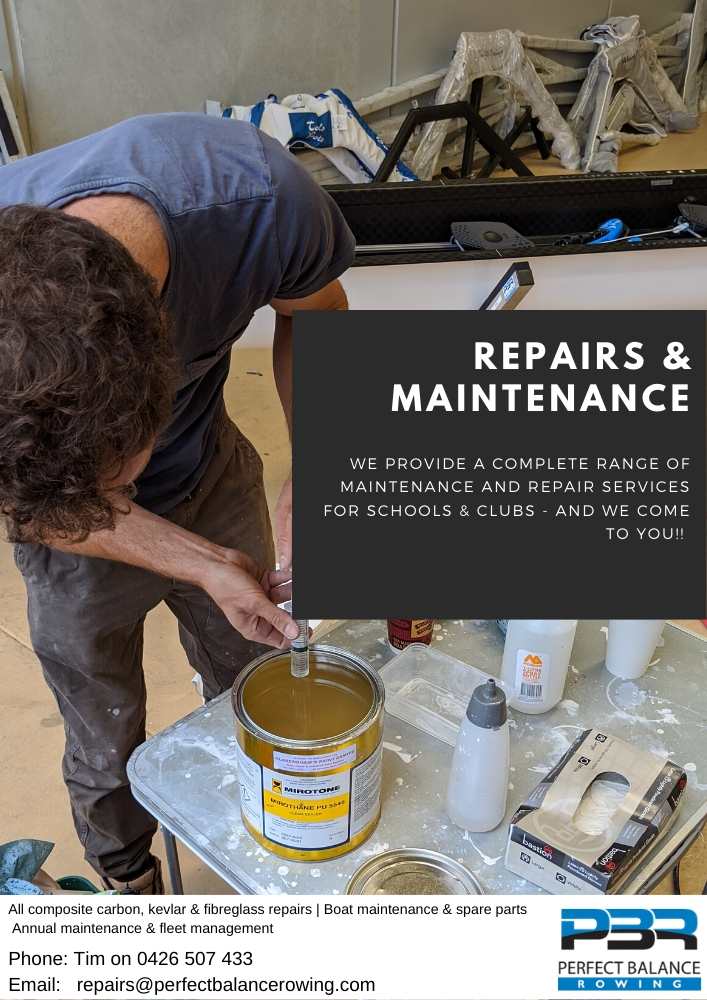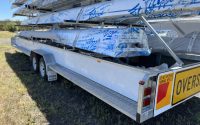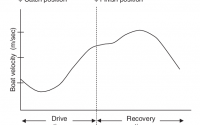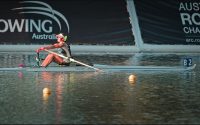WINTER MAINTENANCE: THE ESSENTIALS FOR KEEPING YOUR FLEET AT ITS BEST
With the current coronavirus lockdown and no crew boat rowing, now is a great time to get all those annoying maintenance jobs done on boats that have been neglected. While maintenance can be expensive, it is a far smaller price to pay than crew suffering equipment failure in training, or even worse, in a regatta situation. There is nothing more frustrating for athletes that have put in hundreds of hours of training than to find themselves in a boat that fails on race day.
While each manufacturer has their own specific branded parts, many of the parts for all boat brands can be sourced from the one supplier so it is worth shopping around for the best price as what the same part will cost you can vary significantly from one supplier to another.
Key areas for maintenance include shoes, electronics, seats, slides, rudders/fins, riggers, oars and rowing machines.
Shoes
Shoes are an often underestimated aspect of the boat. However they provide the only fixed contact between the boat and the rower. If used correctly, not only ensure the most effective drive phase but also function to allow the rower to draw the boat back up under them to aid in the continued acceleration of the boat on the drive phase. As a result, having a pair of shoes that fit correctly is absolutely imperative. Another area to consider is the design of the shoe in the event of a capsize. The shoe should have the built in release mechanism but should not be too tight around the heel as this could be problematic in releasing the foot from
the shoe. Shoes vary markedly in quality and fit and like many things in life, you get what you pay for. While you may save some money buying a cheaper shoe, the more expensive shoe will be more comfortable, provide a better connection to the boat, a safer release mechanism and last for many more years than a cheaper shoe.
Top Tip: make sure athletes always wear socks in the boat. Besides being unhygienic not to, the oils in your
feet will accelerate the deterioration of the shoe
Electronics
There is probably no single greater source of frustration in rowing for coaches, coxswains and rowers than electronics. Unfortunately, water and electronics don’t mix well and traditionally the maintenance of electronics has been a very expensive problem with speakers and wiring looms
often requiring replacement annually. The good news is that there is greater competition in rowing electronics, and the new kids on the block are proving to be more reliable. The other good news is that the quality of the speaker systems is improving so that clarity and ability to communicate effectively is increasing. It is worth going through all of your boats and, through a process of elimination, identifying the area that is creating the problem in the boat. Everyone will enjoy their rowing and racing more if the communication in the boat is more reliable.
Top Tip: Get an amplification unit, microphone and speakers that you know work. Then systematically work through your fleet looking for problem spots. Either make notes or remove them immediately and order replacement parts. It is also worth having spare amplification units, speakers and wiring for
regatta days just in case there is a problem on race day (as inevitably there always is!)
Seats
The most likely issue with seats is that the bearing wheels have failed. If you search Youtube for “how to change a rowing wheel” there is a brief and simple video that shows just how easy this is. It is worth shopping around for wheels and buying them in bulk to save money. The other issue with seats is that they go missing from boats – the key here is to always make sure the seats are secured in place when the boats are being transported. Seats can be sourced for your boat from any of the major suppliers
and again it is worth shopping around. A quick comparison from different suppliers shows that seats can vary in price from $185 all the way up to $240+ for what is essentially the same thing.
Top Tip: Make sure to keep your wheels clean and free from dirt and hair around the bearing. Always rinse your
boat with water after a row and avoid using too much detergent. This will help them to last longer
Slides
It staggers me how tolerant rowers are of poorly maintained slides. Rowing is hard enough without having to go back and forth over the Himalayas while racing! To ensure the slides are kept in good order, always clean them thoroughly (not the same cloth you use on the boat!) with a lubricant like WD-40 or RP7. They should be cleaned regularly to avoid any build up. If you get sand or dirt in the slides stop rowing immediately and wash it out of the tracks as the wheels running up and down on top of the debris will result in the anodizing being worn away and the slides will be ruined. Slides come in different lengths so when you are replacing them always check the slide length you need to replace.
Top Tip: often the coloured wheels (not black) have a slightly softer pigment in the plastic which means they do not wear out the anodizing of the slides. Any time you change your slides make sure you change the wheels
Rudders/Fins & Steering Shoes
Fins should be checked to ensure they are straight. If they are aluminium and have been bent and straightened several times it is worth replacing them as they are probably causing a lot of unnecessary drag. If you need to replace the fin, it may be worth paying a professional to do this as damage can result as well as a poor finish if not done properly. All connecting points
for the rudder should be checked as well as ensuring the path that the steering cable navigates is clean, clear of debris and fully functional. The steering shoe should be checked to see that it can move freely and it is
secured correctly to the steering mechanism. If you need to replace the steering shoe, it is worth looking at other boat manufacturers designs to see whether it is an improvement on the existing system. Swift Racing have an outstanding design that is worth retrofitting if the need arises. Top Tip: The yoke or t-bar that sit on top of the rudder and connects the coxswains rudder wires to the rudder is often made of aluminium. The rudder post is often made of stainless steel. As a result the (harder) stainless steel gradually wear out the rectangular hole on the (softer) aluminium. It is worth keeping an eye on this. If you need to replace these parts it is best to go to the boat manufacturer and always ask for the yoke to be supplied in stainless steel if possible to avoid the problem occurring again Oars
One of the most important parts of any rowing equipment is the handle. With the advent of rubber and synthetic handles it is more about changing the grip regularly rather than maintenance. Certain brands last longer and are better to row with when wet but my best advice is to not skimp on changing your handles regularly. In terms of the rest of the oar, I would suggest replacing worn sleeves/buttons, repairing any cracks or fraying of blades and avoiding sun exposure of the shaft as much as possible. Shafts that have been exposed to too much UV light can fade and become incredibly brittle which results in them breaking very easily.
Top Tip: If you need any work done on the oar to repair
shafts, change sleeves or repair/replace blades always use a professional. It is absolutely critical that the “pitch” of the blade is correct (usually 0 degrees) and when changing these components, the professional will use a jig to ensure all is where it should be
Rowing Machines
Now more than every rowing machines are getting plenty of use. On a daily basis the machines should be wiped down to remove any sweat (the electrolytes in our sweat can cause corrosion) and the slides should be maintained so the seat can slide freely. The chain should also be lubricated ion a regular basis. To lubricate the chain, have someone pull the handle all the way out while another person stands at the head of the machine and applies a small amount of oil along the length of the chain. Use a soft, clean and lint free rag to remove the excess oil – repeat as required. More major
maintenance includes changing the cog, chain and the rubber cords that provide the tension on the recovery. Batteries will also require changing from time to time and this is especially important if running selection trials. If rowing machines are a key tool for your rowing program in selecting crews, it is worth having the machines professionally maintained to ensure they are in good working order. Your results could depend on it!
Top Tip: Setting the drag factor is imperative to getting some consistency between machines when testing. If you find that a particular machine has a radically different fan setting when compared to the majority of machines of the same age, it could indicate excessively worn components or faulty electronics. It would not be fair to use this machine to assess your athletes until it is repaired.
If you have any questions about boat maintenance, or
any of the information provided above, please email Alastair Isherwood: al@perfectbalancerowing.com




